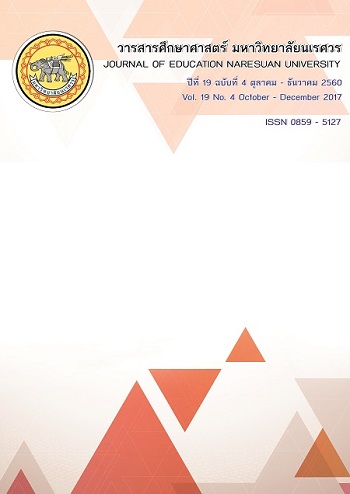DEVELOPING THAI LEARNING MANAGEMENT STRATEGY FOR MULTIGRADE PRIMARY STUDENTS BY APPLYING BALANCED LITERACY APPROACH AND SOCAIL CONSTRUCTIVIST THEORY TO ENHANCE READING ABILITY
Main Article Content
Abstract
The purposes of this research were: to develop and study Thai learning management strategy for multigrade primary students by applying balanced literacy approach and social constructivist theory to develop reading ability. The research was divided into 3 phases; 1) study the theory of reading ability following balanced literacy approach and social constructivist theory, 2) was to develop Thai learning management strategy for multigrade primary students, and 3) was to study the result of Thai learning management strategy for multigrade primary students. A sample was selected from Prathomsuksa 5-6 at JC. Baninplang School in the second semester of the academic year 2015. The research instruments were: 1) lesson plans follow the strategy, 2) Thai reading aloud ability test; the prose reading ability test and the verse reading ability test, and 3) Thai reading comprehension ability test. The study was based on one-group pretest – posttest design. Statistics used in this study were percentage, mean, standard deviation, The Wilcoxon Matched-pairs Sign Ranks Test and The Binomial Test for hypothesis. The Findings of this research were as follows:
1. Approach and theory used to develop the strategy about learning and reading ability management for multigrade primary students are balanced literacy approach and social constructivist theory the results of gathering data from documents, textbooks, coherent researches, interviewing teachers and professors reveal the beneficial principle and method for holding learning activities, suitable environment and school evaluation for using these results as a guideline to draft the learning management strategy.
2. Thai learning management strategy for multigrade primary students by applying balanced literacy approach and social constructivist theory to develop reading ability by the researcher comprised of 5 steps; 1) motivation, 2) reading skills, 3) knowledge sharing, 4) knowledge application, and 5) evaluation. The developed learning management strategy was rated at the highest level.
3. The effects of learning management strategy were found as follows: 1) the student posttest score on reading aloud ability was higher than pretest score at the significantly level of .01, 2) the student posttest score on reading aloud ability was found significantly higher than a specified standard of 70 percent, 3) the student posttest score on comprehension reading ability was higher than pretest score at the significantly level of .01, and 4) the student posttest score on comprehension reading ability was found significantly higher than a specified standard of 70 percent.
Article Details
The owner of the article does not copy or violate any of its copyright. If any copyright infringement occurs or prosecution, in any case, the Editorial Board is not involved in all the rights to the owner of the article to be performed.
References
Berk, L. E., & Winsler, A. (1995). Scaffolding Children’s Learning: Vygotsky and Early Childhood Education. Washington, DC: National Association for the Education of Young Children.
Bureau of Academic Affairs and Educational Standards. (2015). Learning management guideline according to basic education core curriculum (revised version B.E.2553). Bangkok: The Agricultural Cooperative Federation of Thailand. (in Thai)
Bureau of Academic Affairs and Educational Standards. (2015). Good literacy and communication. Bangkok: The Agricultural Cooperative Federation of Thailand. (in Thai)
Certo, S. C., & Peter, J. P. (1991). Strategic management: Concepts and applications. New York: Mc Graw - Hill.
Fitzgerald, J. (1999). What is this thing called “balance?” The Reading Teacher, 53, 100-107.
Frey, B., Lee, S., Tollefson, N., Pass, L., & Massengill, L. (2005). Balanced literacy in an urban school district. The Journal of Educational Research, 98(5), 272-281.
Meesomsarn, K. (2011). Development of a language instructional model integrating balanced literacy approach and cooperative learning to enhance language ability of first grade students (Doctoral dissertation). Bangkok: Chulalongkorn University. (in Thai)
Rief, S., & Heimburge, J. (2007). How to reach and teach all children through balance literacy. San Francisco: Jossey-Bass.
Ruddell, R. B. (2002). Teaching children to read and write: becoming an effective literacy teacher (3rd ed.). Boston, MA.: Allyn and Bacon.
Sanhachawi, A. (2007). Teaching Thai language through balanced literacy approach (Anuban 1-pratomsuksa 6). Bangkok: Association for children education. (in Thai)
Sukkasem, A. (1999). The 022 contemporary literature. Bangkok: Thai Watana Panich. (in Thai)
Vaughn, S. (1999). Promoting reading comprehension, content learning and English acquisition the through collaborative strategic reading (CSR). The Reading Teacher, 52(7), 738-747.
Vygotsky, L. S. (1981). The Development of higher forms of attention in childhood. In J.V. Wertsch (Ed.). The concept of activity in Soviet psychology. Armonk, NY.: Sharpe.


